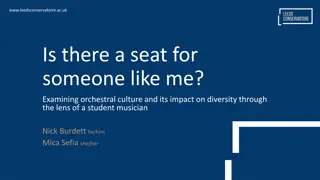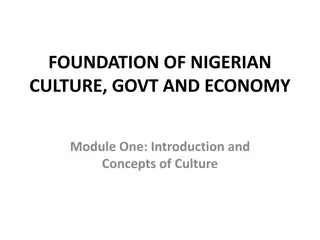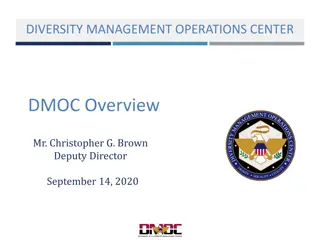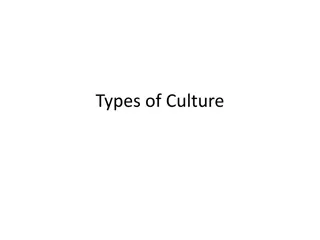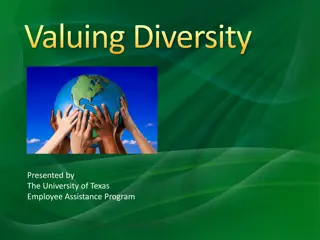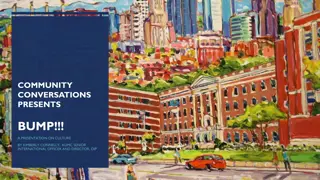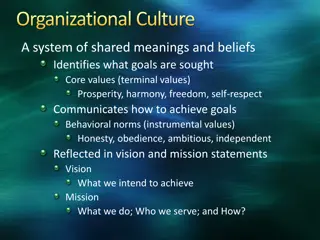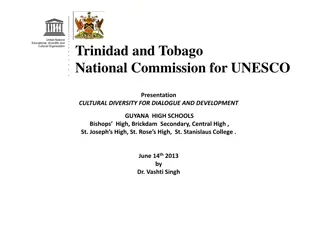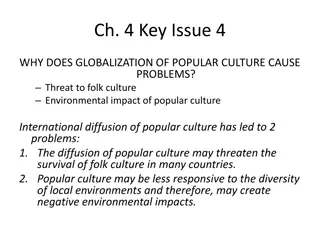Culture and Diversity
Dive into the exploration of culture, diversity, and societal norms. Uncover the complexities of cultural differences, group dynamics, and the significance of behavioral norms. Reflect on the impact of living in a homogeneous versus a heterogeneous community, and ponder the essence of diversity in society.
Download Presentation

Please find below an Image/Link to download the presentation.
The content on the website is provided AS IS for your information and personal use only. It may not be sold, licensed, or shared on other websites without obtaining consent from the author.If you encounter any issues during the download, it is possible that the publisher has removed the file from their server.
You are allowed to download the files provided on this website for personal or commercial use, subject to the condition that they are used lawfully. All files are the property of their respective owners.
The content on the website is provided AS IS for your information and personal use only. It may not be sold, licensed, or shared on other websites without obtaining consent from the author.
E N D
Presentation Transcript
Warm UP Who can define culture? What goes into culture?
Why does Culture Exist? Structural Functionalists Culture provides order and organization to people- a way to belong to something Symbolic Interactionists Culture is what people make of it- They either try to fit in or stand out Conflict Theorists Culture is a way of defining and dividing the haves and have-nots
How to Behave Norms Behaviors that are considered appropriate, normal, and accepted in society We usually do not realize our society s norms until someone breaks them Taboos Behaviors that are outside of the norms in a culture Acting in this way can lead to formal and informal sanctions Ex: Drugs, excessive tattoos, incest
List of various groups School Church Scouting Choir Family Student Union Clubs Sports Fraternities Sororities Work Force (after school job) Band or Orchestra
Group Activity Take Your list with you and to move into groups of 4 students (or less.) compare their individual lists with other people in their group. Identify three things that everyone in their group has in common on their individual lists. On a piece of Chart Paper write down the name of the 3 groups you and your group members have in common Name Purposes of that group (why it is in existence) The beliefs of that group The rules of the group Is membership voluntary or involuntary? You will share one of the three things you and your group had in common with the class, and state the answer(s) you chose for a-e above.
Reflection Would you like to live in a place where everyone: Is the same? (Homogeneous) or Is different? (Heterogeneous)
What is Diversity? Cultural diversity refers to the wide range of cultural differences found between and within nations Can be a result of natural circumstances (climate, geography) or social circumstances (technology or demographics) Societies can be homogeneous or heterogeneous
Have you ever been made to feel like an outsider? When societal tensions arise, people may look for others on whom they can place blame or single out persons or groups who are the outsider , who do not belong.
Subcultures Groups that share many elements of mainstream culture but maintain their own distinctive customs, values, norms, and lifestyles Based on: Age, gender, wealth, sexual preference, education, occupation, ethnicity, music, SES, etc. Examples: Residents of China town, circus people, soldiers in the military s-people Countercultures Deliberately and consciously opposed to certain central beliefs or attitudes of the mainstream culture Organize because of: Inequalities of class, race, age, gender, etc. Examples: Skinheads, Gang members, Hippies OCPA-2005-07-18-105311
Ethnocentrism The practice of judging all other cultures by one s own culture Based on the assumption that one s own way of life is superior to all others Can be positive or negative
Ethnocentrism Judging all other cultures by your own culture s standards Women s rights Dress/ social behavior Thinking your country s ways are the best Culture Shock Disorientation that is felt when encountering a radically different culture Hand signals Language Foods Ways of acting in public Cultural Relativism The belief that all countries should be judged by your country s standards
Why might this map be considered ethnocentric?
Cultural Relativism The belief that the behaviors and customs of any culture must be viewed and analyzed by the culture s own standards
Types of Sanctions Informal Sanctions- Positive or negative consequences given out by members of the group Positive Inviting someone to sit with you in the cafeteria because they helped you in class Formal Sanctions- Positive or negative consequences that are applied by officials Positive good grade given by a teacher Medal of Honor- Gov t Negative Speeding ticket given by a cop Detention given by principal Negative Giving someone a dirty look for telling on you in class Yelling at someone talking/texting loudly in a movie theater
Folk Culture Tastes and creations used by working-class and minorities Produced for and by ordinary people: Spontaneous Familiar Practical Ex. Quilt making, graffiti, break dancing High Culture Tastes and creations used by the upper classes Sets them apart from the rest of society Requires: elaborate training technical proficiency considerable resources Ex. Opera, ballet, fine works of art
Multiculturalism Encourages respect and appreciation for cultural differences Seeks to reverse centuries of cultural intolerance and oppression of minority groups Brought changes to American education and society Global languages Different ethnic literature and perspectives Popular Culture Tastes and items that appeal to the masses Consists of products and items designed for Leisure Entertainment Mass consumption Fashion Fads- short-lived, widespread items/ideas Ex. Baseball cards, Santa Claus, *NSYNC
Complete the Assignment Use one of the magaizines to answer the following handout with your shoulder partner



